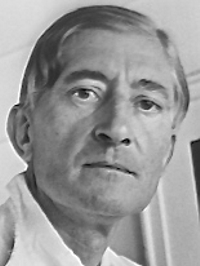 Josef Albers, 1888 – 1976, was a German-born American artist and educator whose work, both in Europe and in the United States, formed the basis of some of the most influential and far-reaching art education programs of the twentieth century. Albers enrolled as a student in the preliminary course of Johannes Itten at the Weimar Bauhaus in 1920. Although Albers had studied painting, it was as a maker of stained glass that he joined the faculty of the Bauhaus in 1922, approaching his chosen medium as a component of architecture and as a stand-alone art form. The director and founder of the Bauhaus, Walter Gropius, asked him in 1923 to teach in the preliminary course ‘Werklehre’ of the department of design. In 1925, Albers was promoted to professor, the year the Bauhaus moved to Dessau.With the closure of the Bauhaus under Nazi pressure in 1933 Albers emigrated to the United States. The architect Philip Johnson, then a curator at the Museum of Modern Art, arranged for Albers to be offered a job as head of a new art school, Black Mountain College, in North Carolina. At Black Mountain, his students included Ruth Asawa, Ray Johnson, Robert Rauschenberg, Cy Twombly. 1950, Albers left Black Mountain to head the department of design at Yale University. In 1963, he published Interaction of Color which presented his very personal theory that colors were governed by an internal and deceptive logic. The rare first edition has a limited printing of only 2,000 copies and contained 150 silk screen plates. This work has been republished since many times.
Josef Albers, 1888 – 1976, was a German-born American artist and educator whose work, both in Europe and in the United States, formed the basis of some of the most influential and far-reaching art education programs of the twentieth century. Albers enrolled as a student in the preliminary course of Johannes Itten at the Weimar Bauhaus in 1920. Although Albers had studied painting, it was as a maker of stained glass that he joined the faculty of the Bauhaus in 1922, approaching his chosen medium as a component of architecture and as a stand-alone art form. The director and founder of the Bauhaus, Walter Gropius, asked him in 1923 to teach in the preliminary course ‘Werklehre’ of the department of design. In 1925, Albers was promoted to professor, the year the Bauhaus moved to Dessau.With the closure of the Bauhaus under Nazi pressure in 1933 Albers emigrated to the United States. The architect Philip Johnson, then a curator at the Museum of Modern Art, arranged for Albers to be offered a job as head of a new art school, Black Mountain College, in North Carolina. At Black Mountain, his students included Ruth Asawa, Ray Johnson, Robert Rauschenberg, Cy Twombly. 1950, Albers left Black Mountain to head the department of design at Yale University. In 1963, he published Interaction of Color which presented his very personal theory that colors were governed by an internal and deceptive logic. The rare first edition has a limited printing of only 2,000 copies and contained 150 silk screen plates. This work has been republished since many times.
His work represents a transition between traditional European art and the new American art. It incorporated European influences from the Constructivists and the Bauhaus movement, and its intensity and smallness of scale were typically European, but his influence fell heavily on American artists of the late 1950s and the 1960s.’Hard-edge’ abstract painters drew on his use of patterns and intense colors, while Op artists and conceptual artists further explored his interest in perception.
